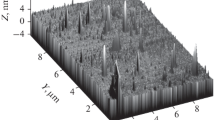Abstract
Rutherford backscattering has been used to study metal/disilicide thin film interactions for Ni and Co. Upon heating, the metal first reacted with the disilicide to form Ni2Si and Co2Si, respectively. After complete consumption of the free metal, the monosilicide phase was found to form at temperatures between 350°C and 550°C. In the case of Co it was found that after all the metal had been converted to CoSi in this way, the reaction stopped. In the Si<>/NiSi2/Ni system, however, all the disilicide converted to NiSi, even though the thickness of the deposited metal was insufficient to account for this. For this to occur, the disilicide had to dissociate into NiSi and Si, with the excess silicon regrown epitaxially on the silicon substrate.
The stability of NiSi2 under various boundary conditions was investigated to determine the factors affecting dissociation. Partial dissociation was found to occur when the NiSi2/Ni reaction proceeded on an inert SiO2 substrate. The disilicide was stable, however, in the Si<>/NiSi/NiSi2 structure. Argon sputtering at temperature was found to induce complete dissociation of NiSi2 on single-crystal Si. We believe that the NiSi2 instability is due to the very small heat of formation from the monosilicide. In such a case, the thermodynamic driving forces are small enough that the reaction can be significantly influenced by the presence of kinetic barriers.
Similar content being viewed by others
References
G. Ottaviani, G. Majni, and C. Canali, Appl. Phys. 18, 285–289 (1979).
K.N. Tu, G. Ottaviani, and R.B. Thompson, J. Appl. Phys. 53, 4406 (1982).
J.M. Gibson, J.C. Bean, J.M. Poate, and R.T. Tung, Mat. Res. Soc. Symp. Proc. 12, 101–110 (1982).
R.T. Tung, J.M. Gibson, and J.M. Poate, Appl. Phys. Lett. 42, 888–890 (1983).
K.N. Tu and J.W. Mayer in: Thin Films-Interdiffusions and Reactions, J.M. Poate, K.N. Tu, and J.W. Mayer, eds. (Wiley, New York 1978) pp. 376–378.
S.S. Lau, J.W. Mayer, and K.N. Tu, J. Appl. Phys. 49, 4005 (1978).
A.P. Botha, “Marker and self-diffusion studies in metal suicides using 31Si” (M.Sc. thesis, University of Stellenbosch, 1980).
F. d’Heurle, S. Petersson, L. Stolt, and B. Strizker, J. Appl. Phys. 53, 5678 (1982).
L.S. Hung and J.W. Mayer, Thin Solid Films [submitted].
E.C. Cahoon, C.M. Comrie, and R. Pretorius, Appl. Phys. Lett. [submitted].
R. Pretorius, J.M. Harris, and M.A. Nicolet, Solid-State Electron. 21, 667 (1978).
Y.J. Chabal, J.E. Rowe, J.M. Poate, A. Franciosi, and J.H. Weaver, Phys. Rev. B 26, 2748–2758 (1982).
E.C. Cahoon, C.M. Comrie, and R. Pretorius [unpublished].
Author information
Authors and Affiliations
Rights and permissions
About this article
Cite this article
Cahoon, E.C., Comrie, C.M. & Pretorius, R. The Reaction between Thin Ni and Co Films and Their Disilicides. MRS Online Proceedings Library 25, 57–62 (1983). https://doi.org/10.1557/PROC-25-57
Published:
Issue Date:
DOI: https://doi.org/10.1557/PROC-25-57



